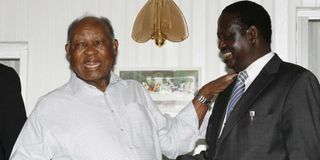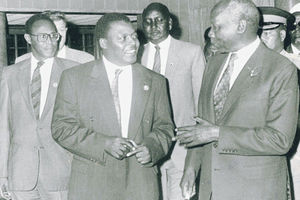Premium
Use-and-dump culture has stunted democracy

ODM leader Raila Odinga (right) and the late veteran politician Kenneth Matiba at his Riara home in 2010.
What you need to know:
- Ford, whose singular agenda was to end the Moi dictatorship, split into Ford-Kenya, led by the doyen of opposition politics in Kenya, Jaramogi Oginga Odinga, and Ford-Asili under Matiba
- With the 2022 General Election beckoning, Deputy President William Ruto and ODM leader Odinga are locked in mortal combat that has produced two major factions.
Some 25 years ago, when I was deeply steeped in the NGO movement, albeit steadfastly within the media, the then-vibrant sector actively debated and poured scorn on some of its variants considered to be up to no good.
As we discussed types of non-governmental organisations, one category, Mongo — the acronym for “My Own NGO” — elicited much derision. It was never really meant to serve the public good. Belonging in the disdained briefcase NGO category, the Mongo’s principal function was to enrich its owner.
Sadly, what began as a peculiarly NGO trait has come to define our politics. With just about two years to the next elections, there is a frenzied purchase of regional loyalty by the big political players devoid of ethical and ideological considerations.
‘Small fish’ are being swallowed by political sharks to give the latter the political muscle to clinch the ultimate crown — the Presidency — as the former ensure their presence at the feeding trough come 2022.
Splintered opposition
When the likes of Oginga Odinga, Martin Shikuku, Charles Rubia and Kenneth Matiba led the formidable campaign that forced Kanu’s 1991 delegates conference to vote to repeal Section 2(a) of the constitution, returning Kenya to multipartyism, nothing would have prepared us for the mayhem ahead. In a year, Forum for the Restoration of Democracy (Ford) — that political juggernaut which captured the nation’s imagination — splintered into smithereens.
Ford, whose singular agenda was to end the Moi dictatorship, split into Ford-Kenya, led by the doyen of opposition politics in Kenya, Jaramogi Oginga Odinga, and Ford-Asili under Matiba. Add to the mix Mwai Kibaki’s Democratic Party (DP) and the splintered opposition had no chance against ‘Baba’ Moi in 1992.
Kanu remained in power until it was swept it away by the National Rainbow Coalition (Narc) political wave. But Narc also collapsed after three years, in 2005, due to a row over a referendum.
With the 2022 General Election beckoning, Deputy President William Ruto and ODM leader Odinga are locked in mortal combat that has produced two major factions. But the leaders of the smaller parties, instead of working on winning political ideologies, are trooping to the two leaders and their acolytes.
Final ballot
The 77 registered political parties (by 2019) are way too many. With less than 10 having a national (actually ethnic) clout, the rest are only meant to tilt the scales in the final ballot.
There’s zero talk on party ideologies to help Kenyans decide. Raw lust for power and the infamous “It’s our-turn-to-eat” syndrome is informing pre-2022 political discourse and formations, threatening peace and cohesion.
I have a message for Raila and Ruto: Spare Kenyans the rising tension. Discard the notion that leadership is only about the Presidency and build the ideological bases of your parties to attract voters — whether in government, opposition or elsewhere.





